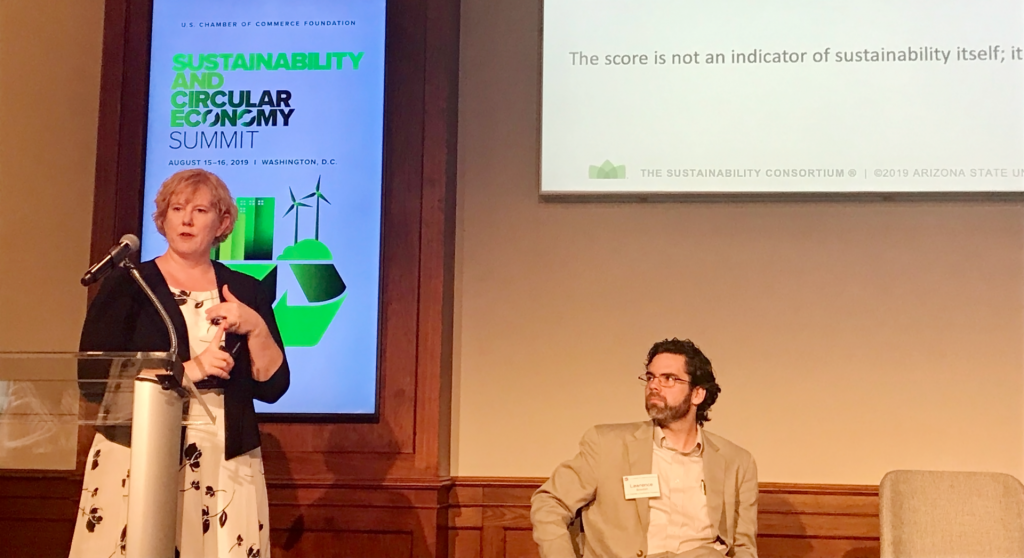
Lead batteries are one of the world’s most successful models of a circular economy. Essential Energy Everyday wants to help other industries follow suit.
We did so recently at the U.S. Chamber of Commerce Foundation’s 5th Annual Sustainability and Circular Economy Summit, held August 15–16 in Washington, D.C. The Summit attracted officials from the Environmental Protection Agency and Department of Energy, as well as a wide range of sustainability leaders from Walgreens Boots Alliance, Kohler, Ocean Conservancy, Subaru, UPS, Coca-Cola, Anheuser-Busch and Essential Energy Everyday.
Panelists Praise Lead Batteries
During a session titled “Data for Good,” our recruited panel of lead battery experts helped policymakers and other influential decision-makers learn more about the sustainability and circular economy of the lead battery manufacturing and recycling industry. A key panelist was Dr. Carole Mars, the director of technical development and innovation for The Sustainability Consortium (TSC). Its mission is to help make consumer products worldwide more sustainable.
“Lead batteries were the first circle that we were actually able to make in one of our supply-chain diagrams. Most of these [other products] will end with a pile, a dump, end of life disposal. But for the lead batteries, that’s not what actually happens. It’s a very tight circular system where the lead coming out of the used batteries goes back into the new batteries,” said Mars to an audience of environment and sustainability executives assembled at the Chamber’s impressive headquarters across from the White House.
She was referring to the more than 100 consumer products that TSC has studied to evaluate their sustainability KPIs (key performance indicators) in five categories: climate and energy, worker health and safety, emissions control, resource conservation, and responsible sourcing.
TSC research concludes that the closed-loop system of lead batteries is a model of a circular economy. That means one defined as make, use, recycle and remanufacture. This is in sharp contrast with the traditional linear model to make, use and dispose.
The Benchmark: Lead Batteries
According to Battery Council International, 99.3% of all lead batteries are recycled, compared to the less than 5% recycling rate of lithium-ion batteries. Mars said TSC is looking at how to use the lead battery model in other chemistries, and that lithium-ion battery chemistry is on everyone’s mind. TSC is working with the Responsible Battery Coalition to look at that battery’s manufacturing infrastructure and what’s needed to get lithium – and future battery chemistries – to the same circularity level as lead batteries.
Consistent Chemistry Simplifies Collection and Sorting
What factors help make the lead battery industry a circular success? A lead battery has a fairly standard chemistry (lead, plastic and sulfuric acid) that creates uniformity, regardless of the battery manufacturer. Technology-wise, this standardization streamlines battery collection and recycling. It doesn’t matter who made the battery; it can be broken down and recycled. Mars pointed out a universal fact of recycling: the more diverse the materials and chemistries, the harder they are to sort.
Keeping a Sustainability Scorecard
In keeping with the “Data for Good” theme, Mars explained KPI scoring. Lead batteries’ KPI score is 68.64%, among the highest of any consumer product that TSC studied, and one of five product categories in their highest ranking, called “The 64 and Over Club.”
“Sustainability scoring is an interesting beast…the way we approach our measurements is that the score is not an indicator of how sustainable you are. It’s a matter of how well you know your supply chain, how well you are talking to your vendors both upstream and downstream from where you are, and what you are doing to address those issues that are going to make you more sustainable.
“If you’re getting a score of 100% on one of our surveys, we either wrote the questions wrong or maybe you’re fibbing, because that’s really not what this is about. It’s about continual improvement, about identifying new issues and moving the bar forward.” That, Mars concluded, is why she’s honored and pleased to be working with the lead battery industry.
“They take this seriously and are looking at how to keep moving the bar forward.”
Indeed, we are.
Stay tuned for our next post on this topic when we highlight the presentations from Chris Pruitt, CEO/president of East Penn Manufacturing, and Dr. Mark Drezdzon, vice president of research and development of RSR Technologies.
Learn More
InsideEPA.com: Lead Batteries’ Top Sustainability Score May Be Model For Other Sectors
The Sustainability Consortium
News Release: Lead Batteries A Model of Circular Economy at D.C. Sustainability Summit
Chamber of Commerce Foundation 5th Annual Sustainability and Circular Economy Summit
Nielsen: The Evolution of the Sustainability Mindset
East Penn Manufacturing
RSR Technologies


